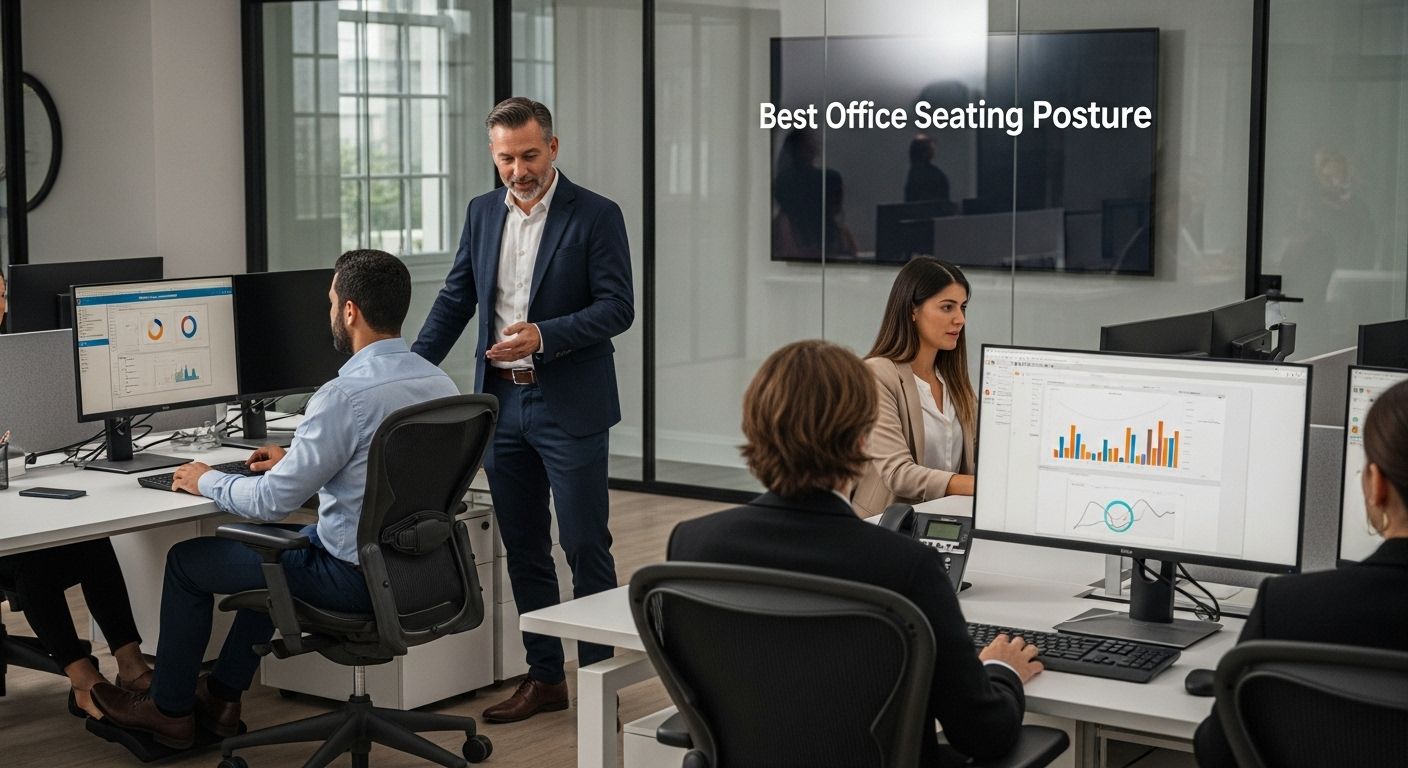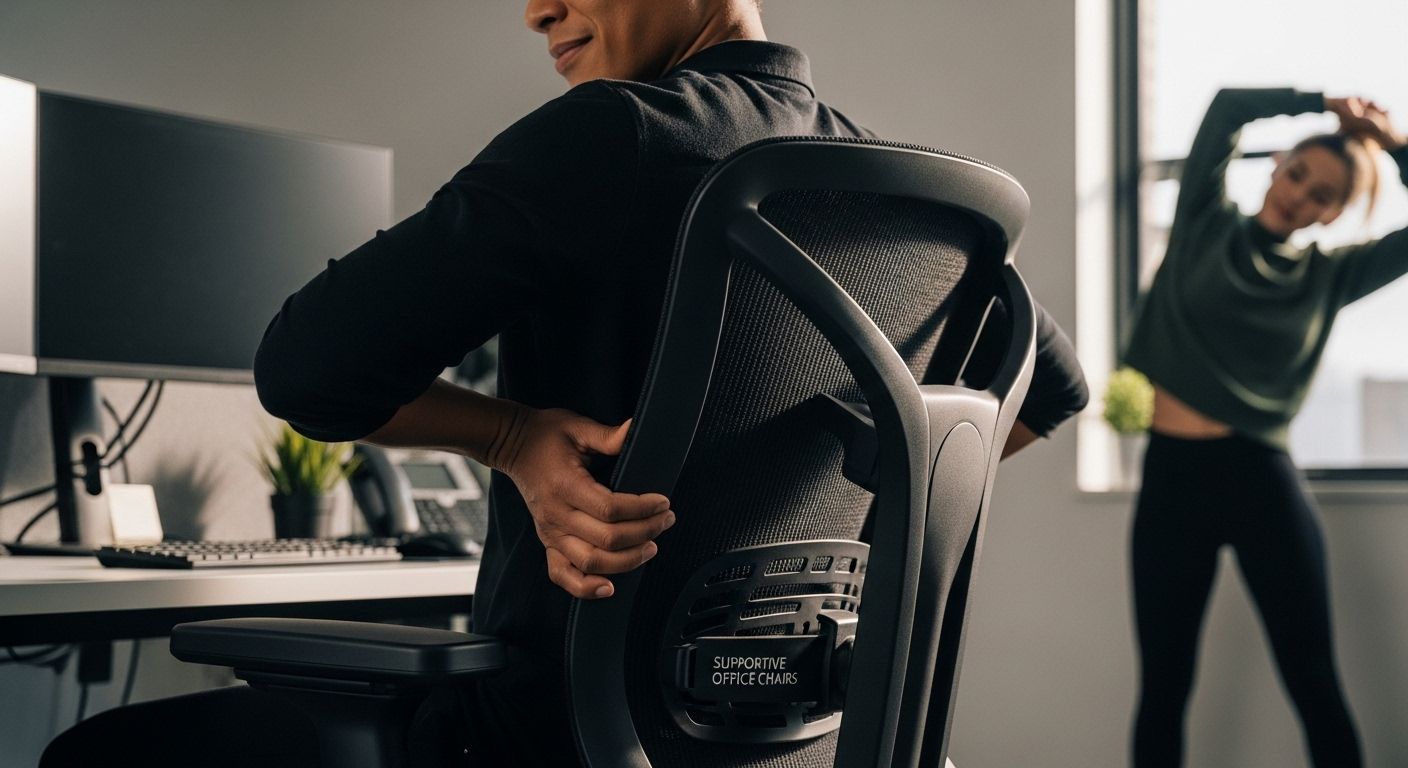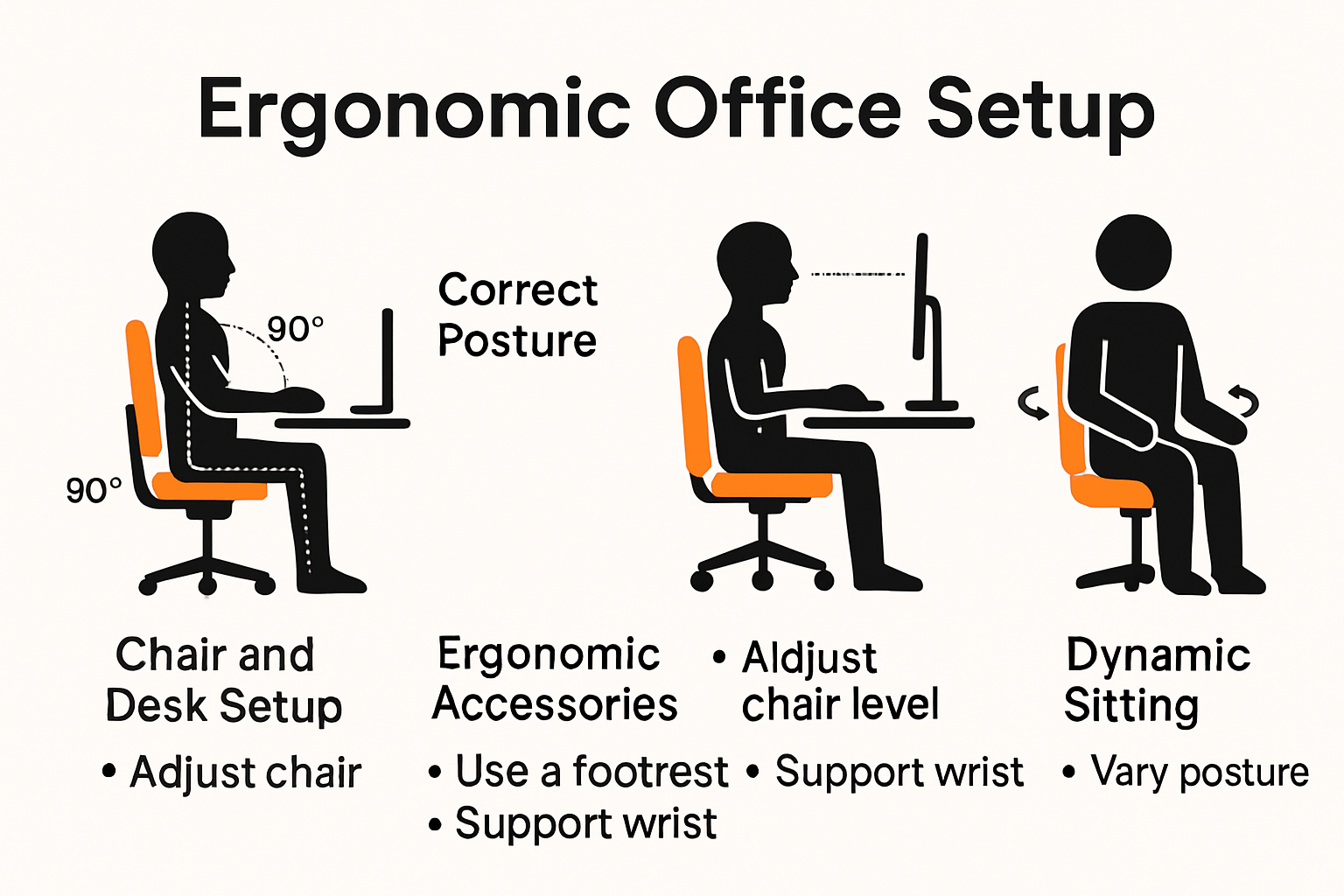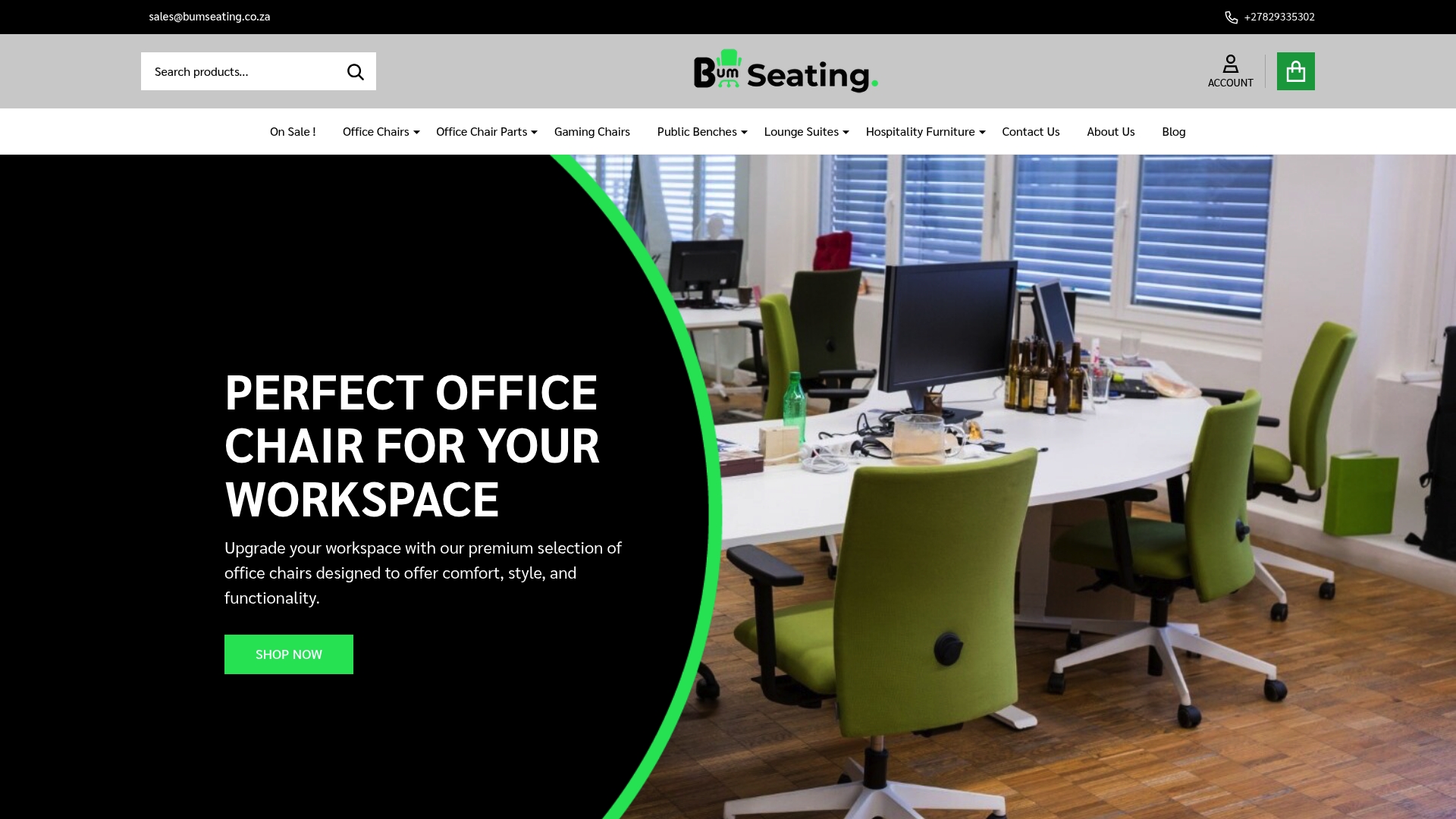Best Office Seating Posture for Healthy Workspaces
15th Aug 2025
Best Office Seating Posture for Healthy Workspaces

Most people spend about 8 hours a day sitting at their desks and you might think a comfy chair is enough for a healthy workspace. But shockingly, sitting incorrectly for long periods increases your risk of chronic back pain by up to 54 percent. The real eye-opener is that even the fanciest chair does nothing if your posture is off. There is a simple shift you can make to transform how you feel at your desk every single day.
Table of Contents
- Understanding Best Office Seating Posture
- Key Features Of Supportive Office Chairs
- Practical Tips To Improve Your Sitting Posture
- Office Design Solutions For Better Posture
Quick Summary
| Takeaway | Explanation |
|---|---|
| Maintain a Neutral Spine | Keep your back straight and shoulders relaxed to reduce strain. This supports overall body alignment and prevents discomfort during prolonged sitting. |
| Choose the Right Chair | Select chairs with adjustable height and lumbar support. This ensures proper fit and alignment, minimizing the risk of musculoskeletal issues. |
| Incorporate Dynamic Sitting | Use movement techniques such as stretching and frequent adjustments. Dynamic sitting helps prevent fatigue and promotes better circulation. |
| Design a Flexible Workspace | Create an office layout that accommodates both sitting and standing. This encourages movement and reduces prolonged static positions that can lead to discomfort. |
| Utilize Ergonomic Accessories | Implement monitor arms and adjustable keyboards to enhance posture. These tools promote natural alignment and assist in reducing physical strain. |
Understanding Best Office Seating Posture
Maintaining proper seating posture is critical for workplace health and productivity. At Bum Seating, we understand that how you sit can dramatically impact your overall physical wellbeing and professional performance. Office workers spend significant portions of their day seated, making ergonomic awareness essential for preventing long-term health complications.
The Biomechanics of Optimal Sitting
Understanding proper seating posture requires comprehending human biomechanics and spinal alignment. According to the Mayo Clinic, maintaining a neutral spine position is fundamental to reducing musculoskeletal strain. This means keeping your back straight, shoulders relaxed, and feet firmly planted on the ground. Bum Seating’s ergonomic chair designs are specifically engineered to support these natural body mechanics.
The human spine has natural curvatures that should be supported, not forced into unnatural positions. When seated incorrectly, individuals can experience increased pressure on vertebral discs, leading to potential chronic pain and reduced mobility. Research published in PubMed highlights how chair design directly influences lumbar spine posture and muscle activity during prolonged sitting.
Key Principles of Ergonomic Seating
Ergonomic seating isn’t just about comfort—it’s a strategic approach to preventing workplace-related physical stress. Key principles include:
- Spine Alignment: Maintain a natural S-curve that supports your spine’s inherent structure
- Joint Positioning: Keep elbows, knees, and hips at approximately 90-degree angles
- Weight Distribution: Ensure your body weight is evenly spread across the chair
For those seeking comprehensive insights into workplace seating solutions, explore our guide on chair selection to find the perfect ergonomic match for your workspace.
By prioritizing proper seating posture, individuals can significantly reduce the risk of developing repetitive strain injuries, chronic back pain, and other musculoskeletal disorders. Bum Seating remains committed to providing innovative seating solutions that promote health, comfort, and professional performance.
Call to Action: Ready to transform your workspace? Visit Bum Seating today and discover ergonomic chairs designed to support your body’s natural alignment and enhance your daily comfort.
Key Features of Supportive Office Chairs
Selecting the right office chair is crucial for maintaining optimal workplace health and productivity. At Bum Seating, we understand that a supportive chair is more than just a piece of furniture—it’s an essential tool for professional wellbeing. According to the National Institutes of Health, a well-designed office chair can significantly reduce the risk of musculoskeletal disorders and improve overall workplace comfort.
Fundamental Ergonomic Design Elements
Ergonomic office chairs require several critical design features to provide comprehensive support. The Occupational Safety and Health Administration (OSHA) recommends chairs with specific characteristics that promote proper body alignment and reduce physical strain.
To help readers quickly understand the fundamental ergonomic features of supportive office chairs, the following summary table lists essential design elements and their benefits, as described in the article.
| Feature | Description | Benefit |
|---|---|---|
| Adjustable Seat Height | Allows users to position feet flat on the ground | Supports proper leg and spine alignment |
| Dynamic Lumbar Support | Provides targeted support to lower back | Prevents spinal compression |
| Flexible Seat Depth | Enables seat depth adjustments for different body types | Accommodates a wide range of users |
| Synchronous Tilt | Chair moves in sync with body’s movement | Promotes active sitting |
| Responsive Backrest Tension | Adjusts resistance as users lean back | Reduces static posture and strain |
| Breathable Mesh Materials | Improves air circulation in the backrest | Increases comfort during extended use |
Key ergonomic design elements include:
- Adjustable Seat Height: Allows users to position their feet flat on the ground, maintaining proper leg and spine alignment
- Dynamic Lumbar Support: Provides targeted lower back support to prevent spinal compression
- Flexible Seat Depth: Accommodates different body types by allowing seat depth adjustments
Advanced Support Mechanisms
Beyond basic adjustments, modern office chairs incorporate sophisticated support mechanisms. Research from the University of California, Davis highlights the importance of chairs that adapt to individual body mechanics.
Advanced features like synchronous tilt mechanisms, responsive backrest tension, and breathable mesh materials transform traditional seating into dynamic support systems. These innovations allow chairs to move with the user, promoting active sitting and reducing static posture-related strain.
Learn more about our innovative chair designs that combine cutting-edge ergonomic technology with professional aesthetics.
By investing in a chair with comprehensive support features, professionals can protect their physical health, enhance comfort, and improve overall workplace performance. Bum Seating remains committed to delivering chairs that not only meet but exceed ergonomic standards, ensuring every user experiences optimal comfort and support.

Call to Action: Upgrade your workspace comfort today. Explore Bum Seating’s range of ergonomically designed chairs and discover the difference professional-grade support can make in your daily work experience.
Practical Tips to Improve Your Sitting Posture
Optimizing your sitting posture is a critical skill that goes beyond simply selecting the right chair. At Bum Seating, we recognize that conscious body positioning and strategic workplace habits can significantly impact overall physical health and professional productivity. According to the National Institute for Occupational Safety and Health (NIOSH), maintaining proper posture involves more than static positioning—it requires dynamic awareness and intentional movement.
Workplace Posture Fundamentals
Effective posture management begins with understanding your body’s natural alignment. Start by positioning your workstation to support optimal ergonomic positioning. This means ensuring your computer monitor is at eye level, preventing unnecessary neck strain. Your keyboard and mouse should be positioned to keep your elbows at approximately 90 degrees, allowing your shoulders to remain relaxed and preventing unnecessary tension.
Key positioning strategies include:
- Align your ears directly over your shoulders
- Keep your shoulders relaxed and pulled slightly back
- Maintain a neutral spine position
- Distribute body weight evenly across your chair
Dynamic Sitting Techniques
Static posture is as harmful as poor posture. Professionals should incorporate movement and position changes throughout their workday. This approach, often called “active sitting,” helps prevent muscle fatigue and maintains circulatory health.
Implement micro-movements such as:
This process table highlights actionable dynamic sitting techniques for office workers. The steps are organised to help you incorporate more movement and optimise posture throughout your workday.
| Technique | How to Apply |
|---|---|
| Periodic Stretching | Stretch muscles at intervals during the workday |
| Subtle Chair Adjustments | Regularly shift posture or change seating angles |
| Walking Breaks | Take short walks every 30-45 minutes |
| Use Rocking/Tilting Chairs | Sit on chairs that allow gentle rocking or tilting |
| Standing Desk Converters | Alternate between sitting and standing |
| Balance Ball Chairs | Use occasionally to engage core muscles |

- Periodic stretching
- Subtle chair adjustments
- Short walking breaks every 30-45 minutes
- Using chairs with slight rocking or tilting mechanisms
Discover our ergonomic chair solutions for dynamic workspaces that support continuous movement and comfort.
Additionally, consider incorporating supplementary tools like standing desk converters or balance ball chairs to introduce variety into your sitting routine. These alternatives can help engage core muscles and promote better overall posture.
Remember that improving sitting posture is a gradual process. Consistent awareness and intentional adjustments will lead to significant long-term health benefits. Bum Seating remains committed to providing ergonomic solutions that support your journey towards better workplace health.
Call to Action: Transform your workspace experience. Explore Bum Seating’s innovative ergonomic chairs designed to support your body’s natural movement and promote optimal workplace comfort.
Office Design Solutions for Better Posture
Creating a workspace that promotes healthy posture requires more than selecting individual furniture pieces. At Bum Seating, we understand that comprehensive office design plays a crucial role in supporting employee physical wellbeing. A 2021 study published in Applied Ergonomics emphasizes how strategic workspace configurations can significantly impact employee comfort and musculoskeletal health.
Integrated Ergonomic Workspace Planning
Effective office design begins with a holistic approach to workspace configuration. This means considering how different elements interact to support natural body movement and posture. Workstations should be designed to accommodate individual variations in body type, work style, and physical requirements. Key considerations include creating flexible spaces that allow employees to alternate between sitting and standing positions, ensuring proper equipment placement, and minimizing physical strain.
Critical design elements include:
- Adjustable workstations with height-variation capabilities
- Strategic equipment positioning
- Zones that encourage movement and posture changes
- Sufficient space for natural body movement
Technology and Posture Support
Modern office design integrates technology to support optimal posture. Smart workstations with built-in ergonomic sensors can provide real-time feedback about sitting position, alerting users when they maintain static postures for too long. Monitoring systems can track employee movement, suggesting breaks and recommending posture adjustments.
Explore our innovative workspace solutions that blend cutting-edge design with ergonomic functionality.
Additionally, consider incorporating accessories like monitor arms, adjustable keyboard trays, and ergonomic footrests. These tools help create a more adaptable workspace that can be customized to individual needs, promoting better alignment and reducing physical strain.
Bum Seating recognizes that optimal office design is an investment in employee health, productivity, and long-term workplace wellness. By creating environments that support natural body mechanics, organizations can reduce the risk of musculoskeletal disorders and enhance overall worker comfort.
Call to Action: Transform your workspace into a health-supporting environment. Discover Bum Seating’s comprehensive range of ergonomic solutions designed to promote better posture and workplace wellbeing.
Frequently Asked Questions
What is the best sitting posture for office work?
Maintain a neutral spine position by keeping your back straight, shoulders relaxed, and feet flat on the floor. This alignment helps to reduce strain and prevent discomfort during prolonged sitting.
How can I improve my sitting posture at work?
To improve your sitting posture, ensure that your workstation is set up ergonomically. Position your computer monitor at eye level, keep your elbows at 90-degree angles, and use an ergonomic chair with lumbar support. Regular movement and stretching breaks further enhance posture.
What features should I look for in an ergonomic office chair?
Look for adjustable seat height, dynamic lumbar support, flexible seat depth, and a synchronous tilt mechanism. These features promote better alignment and comfort by accommodating individual body types and movements.
How does office design affect posture and comfort?
Office design greatly impacts posture by affecting how workstations are arranged and equipped. A well-planned workspace should allow for flexibility in sitting and standing, incorporate ergonomic accessories, and provide ample room for natural movement, all of which contribute to better posture and overall comfort.
Upgrade Your Posture With Trusted Office Seating Solutions
Are you struggling with persistent back pain or fatigue during your workday? The article “Best Office Seating Posture for Healthy Workspaces” highlights that the real challenge isn’t just sitting for long hours. It’s the toll that poor posture and lack of proper support can take on your overall health and productivity. Feeling stiff, uncomfortable or drained after hours at the desk is more common than you think. Many readers share the goal of achieving a workspace that genuinely supports their body’s natural alignment, just as described in the article’s discussion about maintaining a neutral spine and using truly ergonomic chairs.
Imagine an office chair that adapts to your unique body, encouraging healthy sitting habits and reducing strain every single day. If you want real change, take action to protect your health and comfort with seating solutions designed for performance and wellbeing.

Visit our Bum Seating site and discover office chairs that match the best ergonomic principles you read about. Explore our ergonomic and executive chair selection for seating that makes good posture easy and empowers you to work better for longer. The right chair can help you transform long hours at your desk into a much healthier and more productive experience. Browse today for chairs and accessories that fit your space and budget—your back will thank you for making the change.
Recommended
- Types of Office Chairs for Every Workspace in 2025 - Bum Seating
- Office Furniture for Wellbeing: Smart Choices for 2025 - Bum Seating
- Ergonomic Furniture Basics: Your Guide to Healthy Spaces - Bum Seating
- Why Use Gaming Chairs for Modern Office Spaces - Bum Seating
- Enhance Your Workspace with Essential Ergonomic Chair Features
